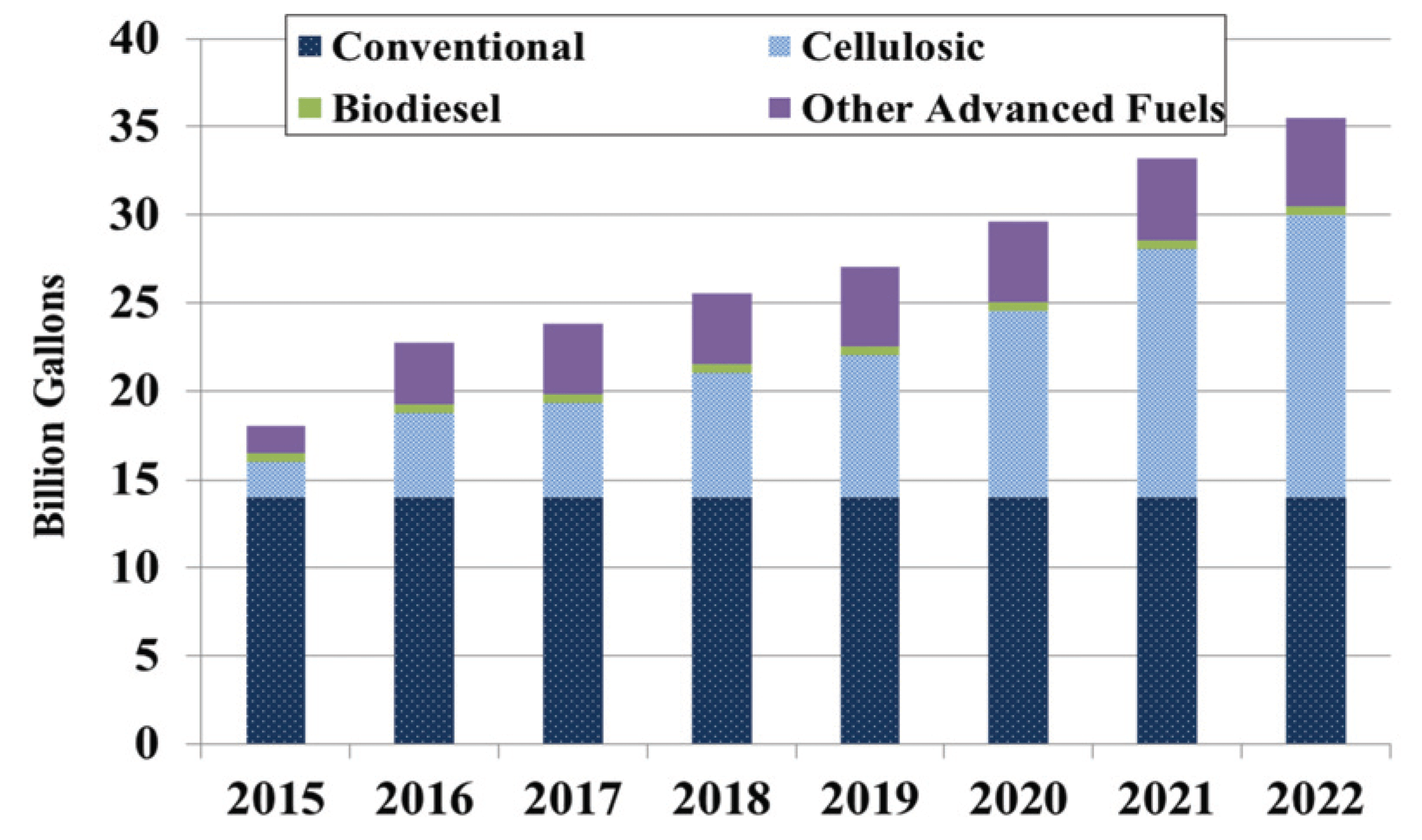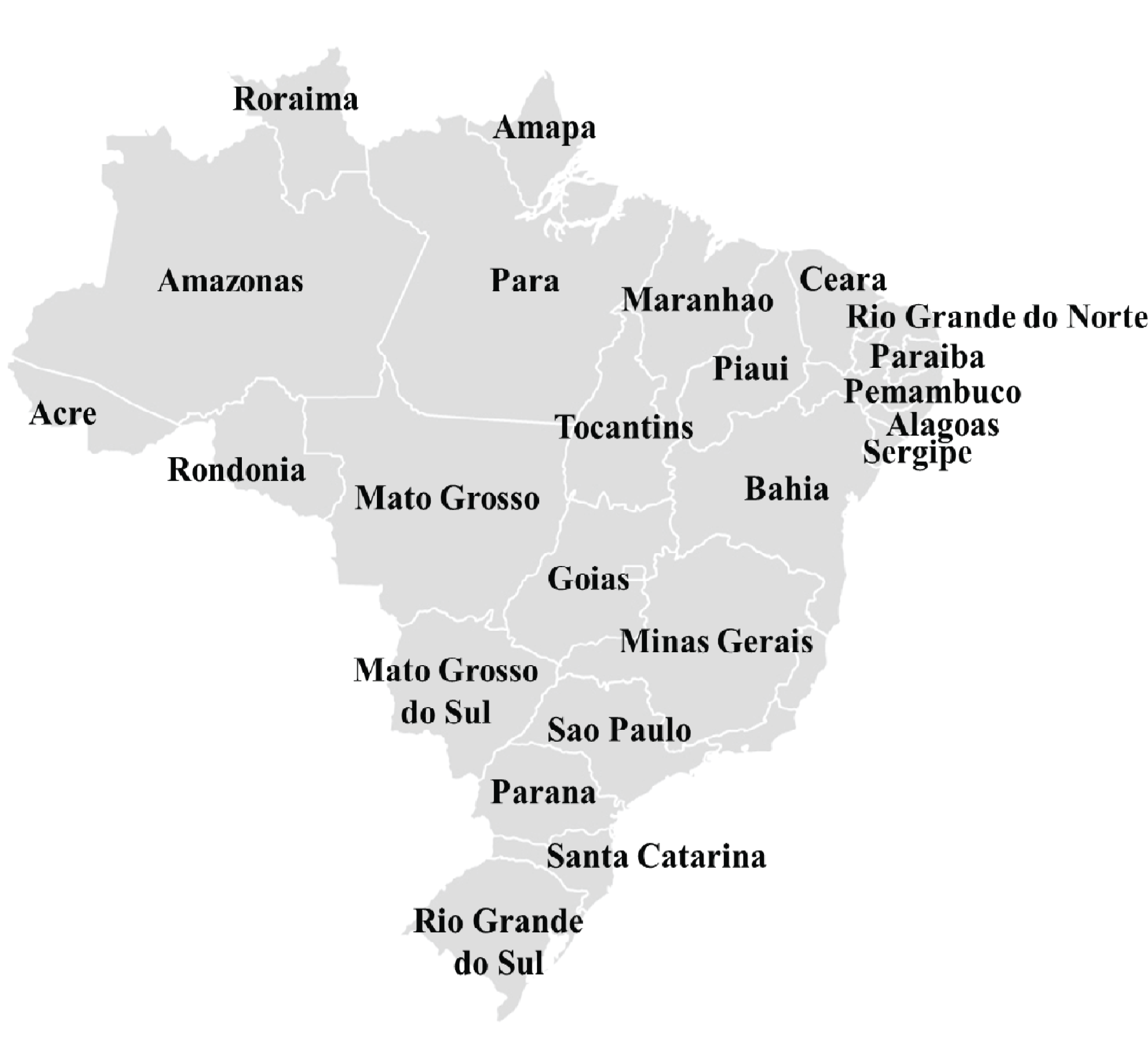1. INTRODUCTION
Sea level rise caused by global warming and environmental problems such as increased harmful substances have become global issues, and development and utilization of renewable energy can be said to be a task to be solved by all countries. As a result, research on renewable energy which can replace fossil fuels worldwide has been spotlighted. Typical expected benefits obtained by using biofuels include mitigation of climate change, improvement of energy security and job creation in rural areas.
Corn produced through fermentation in the United States (U.S.), bioethanol derived from sugarcane in Brazil, and biodiesel produced from oil seed1) through alkyl esterification in the European Union (EU) are typical biofuels. As such, biofuel is used as practical alternative fuel but ASEAN2) countries are far from how the U.S. and the EU which are taking active policies to use biomass.3) Although it is difficult to apply the same level of policies of the developed countries, effective biofuel policies are expected to be implemented through the cases. In the previous study, the author examined the use and prospect of Lignocellulosic bioethanol in ASEAN countries (Heo and Choi, 2017). However, it was confirmed that there are limitations to enforcement of policies due to technical limits. Thus, this study is conducted to find a method for complementing this. The current size and status of the cellulosic bioethanol market are very limited to replace targets of each country (Kim, 2016). Although there is a case of applying to the domestic situation by analyzing the precedent set by the developed countries (Cho and Lee, 2013; Park, 2011), this study has a different significance because it is based on the situation of ASEAN countries. This study looked at Renewable Fuel Standard and biofuel supply policies of the U.S. and Brazil which are based on bioethanol, and the EU which is based on biodiesel. The policy background and plan of Renewable Fuel Standard (RFS) and Renewable Energy Directives (RED) are set out and the utilization methods of biofuel in the U.S., Brazil and Europe are analyzed as overseas cases. The current biofuel policies adopted in ASEAN countries are investigated. Based on this, implications on policies of ASEAN countries, which need to be improved at this stage, are explored through the related cases of the developed countries.
2. MATERIALS and METHODS
RFS was enacted by the Energy Policy Act4) in the U.S. in 2005 and the scope was expanded by the EISA5) in 2007. This was firstly enforced to impose the biofuel Renewable Fuel Standard on the transportation industry within the U.S., and biofuel used here includes bioethanol and biodiesel of the first and second generations (Bracmort, 2015). The main contents of RFS I are suggest the Renewable Fuel Standard and include the tracking system based on RIN6) and general exemption provision for business management (Cho and Lee, 2013). According to DOE7), the person of obligation can meet the Renewable volume obligations8) by selling the required amount of biofuel or purchasing RIN from a person that exceeds the requirement. Thus, the company must own RIN that corresponds to the calculated biofuel. If not, a maximum of 32,500 USD is imposed per day (Cho and Lee, 2013).
However, there are cases of reducing the amount as they cannot meet the RFS I target and RFS II appeared in 2010 to complement RFS 1 (2007). Unlike RFS I, it defined the types of biofuel in details and suggested the practical Renewable Fuel Standard target (Bracmort, 2015). Biofuel defined by DOE must meet the minimum target of life cycle9) GHG emission reduction compared to petroleum and the criteria are as follows: 1) Biofuel of the first generation10) - reduce by more than 20% in life cycle of GHG; 2) Advanced11) biofuel - i. Biodiesel - reduce by more than 50%, ii. Cellulosic biofuel - reduce by more than 60%. The U.S. Energy Environmental Protection Agency (EPA) manages the RFS program and sets the amount based on the EISA law and requirements for the amount of each category in accordance with fuel availability (DOE, 2017). In general, EPA12) evaluates based on the information such as individual production plan and progression speed, which is obtained through discussion with each producer, EIA13), USDA14) and DOE15) to determine the amount to be imposed on Renewable Fuel Standard volumes of cellulosic biofuel (Bracmort, 2015). Fig. 1 anticipates Renewable Fuel standard volumes that generally increased by year. It shows that cellulosic biofuel and advanced biofuels are increasing compared to the first generation (conventional) biofuel and biodiesel that are at a constant rate.
The EU enacted Renewable Energy Directives (RED) in 2009 and the objectives are set differently by country or region. REDs are guidelines to reduce GHG emission and dependence on fossil fuels by imposing the minimum standard for use of biofuels such as bioethanol and biodiesel (Dixon et al., 2016). The EU Commission16) set up a goal of reducing GHG by 6% by increasing biofuel in the transportation industry up to 10% until 2020 (Dixon et al., 2016; EU Commission, 2018). In addition, the objective was set in 2016 to meet the minimum 30% of the overall energy required in the field of renewable energy by 2030, but each country has a different goal such as 10% for Malta and 49% for Sweden. One year later, in December 2017, downward adjustment on renewable energy was made to 27% and EU countries can reset their national objectives based on the 2-year performance through this goal (Council of the EU, 2017). REDs not only help EU countries and other countries to meet the renewable energy objectives through cooperation but suggest the sustainability requirements to produce all biofuels produced or consumed in the EU in a sustainable and eco-friendly way. For instance, the minimum share of advanced biofuels is expected to be increased gradually from 0.5% in 2021 to more than 3.6% in 2030, and agricultural biomass used here must meet the following criteria: (1) To have a high biodiversity value; and (2) To be produced based on the raw material that is grown in soil with low carbon deposition (Council of the EU, 2017). Companies that produce biofuels can prove the compliance status through these sustainability criteria or voluntary plans approved by the EU Commission. Biofuels here are mostly based on the first generation (conventional) biomass, and RED II was enacted in 2016 to complement this. It targets 6.8% fuel blending by 2030, and it is based on advanced biofuels that exclude the first generation (conventional) fuels unlike the existing RED (EU Commission, 2018). The obligation of life cycle GHG emission reduction for fuel suppliers was added to the existing RED and the detailed criteria on which cases are to be included in GHG emission were set. These criteria include 1) nitrogen dioxide emission from soil during farming; 2) emission during extraction of vegetable oil; and 3) emission during transportation and distribution of final fuel.
3. RESULTS and DISCUSSION
The U.S. produces nearly half of global ethanol, which is mostly produced using corn as a raw material. Ethanol production consumed 107 million tons of corn in 2009 and 112 million tons in 2010, corresponding to about one-third of overall corn production in the U.S. and 13% of global production (Goto, 2012).
EPA is currently considering to change E1017) into E15 and enforces a strong policy in the field of biofuel to improve energy security (Park, 2011). It has recently been paying attention to advanced biofuel. Oklahoma is encouraging the abolition of the system that deducts 45 cents of tax per one gallon of corn-based bioethanol in gasoline (Park, 2011). According to Goto (2012), the U.S. has been offering tax reduction for federal taxes on gasoline with bioethanol content of 10% or above since 1978. Various affirmative actions related to biofuel have been implemented, such as tax credit in 2004 for ethanol facilities at gas stations. Looking at different states, Illinois and 10 other states offer tax reduction for sales tax on gasoline and Minnesota and 17 other states provide subsidies to bioethanol providers (Goto, 2012). Fig. 2 indicates locations of bioethanol suppliers that meet Renewable Fuel Standard in major cities of the U.S. Suppliers that produce high-blend fuel are placed in the Gulf and the Midwest. EISA set a goal to increase from 42 billion liters (1.1 billion gallons) in 2009 to maximum of 136 billion liters (36 billion gallons) by 2022 (APEC, 2015). However, such goal comes with a clause that the goal can be lowered if the cost is too high or biofuel supply is insufficient. For instance, as EPA failed to reach 22.25 billion gallons/year planned by the U.S. Congress in 2007, the goal was lowered to produce 18 billion gallons/year of bioethanol by 2016 and 15 billion gallons/year by 2022 (APEC, 2015; APEC, 2016).
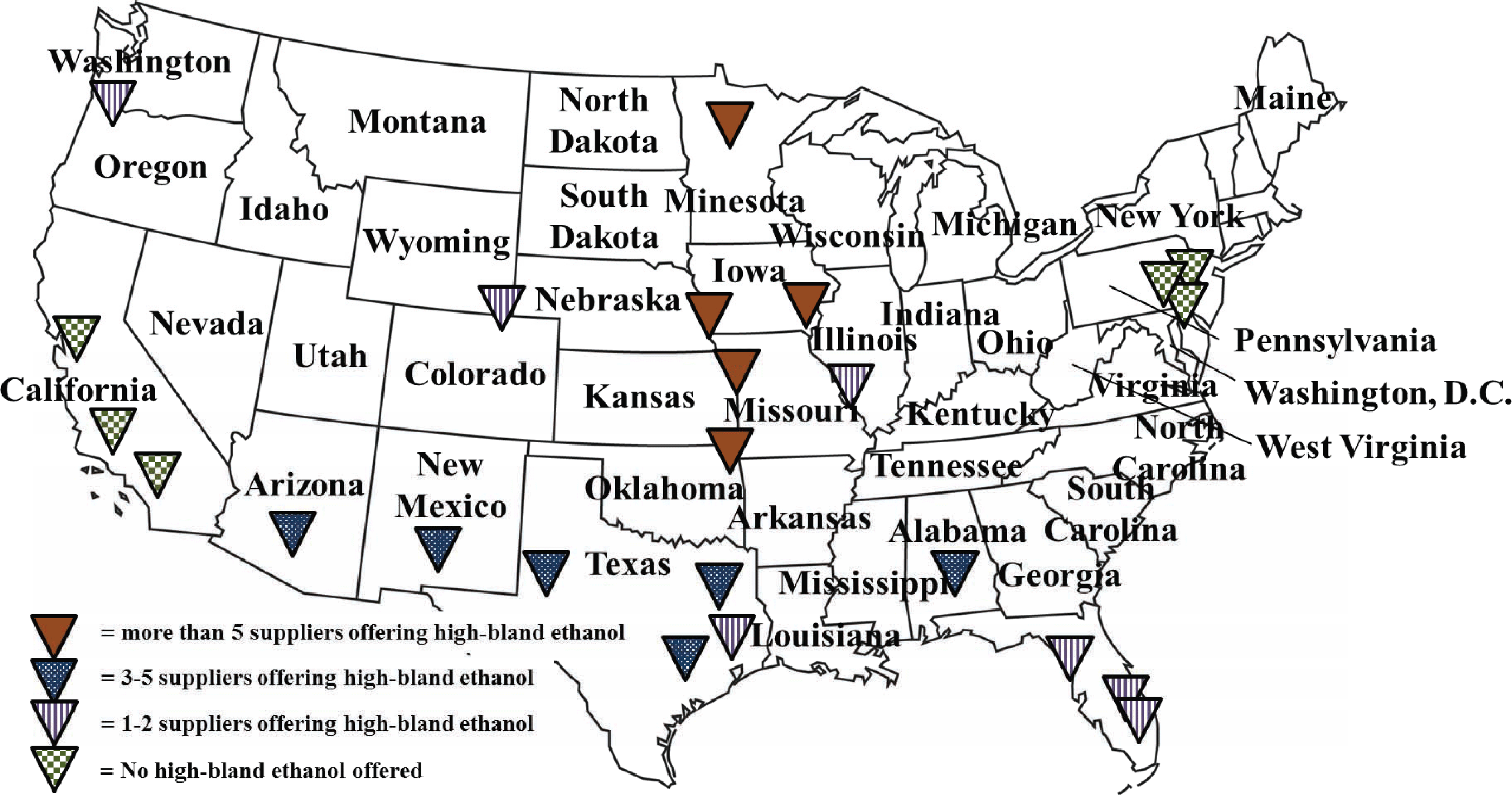
Brazil enacted the National Alcohol Program in 1975 to reduce its dependence on import of fossil fuel, which was increased by the first oil crisis in 1973. Due to low availability of bioethanol, the original target of E25 was not satisfied and the actual ratio was dropped to E20 in 2011. E25 was recovered in June 2012 and Renewable Fuel Standard was increased to E27 in 2015 (USDA, 2017). Actual consumption of bioethanol is higher than the standard because pure ethanol is not only used for gasoline blending but also on vehicles like FFV18) (Brazil biofuels, 2016). Bioethanol in Brazil is mostly produced using sugarcane cultivated domestically. Sugarcane production was increased by nearly 1.7 times in 6 years, from about 396 million tons in 2003 to about 671.39 million tons in 2009 (Goto, 2012). Starting in December 2004, Brazil implemented the National Program for the Production and Use of Biodiesel (PNPB)19) to increase national production of biodiesel (Brazil biofuels, 2016). The objective of this program is to require legal, administrative and normative measures, define a federal tax model for biodiesel, and establish the conditions for registering producers and importers. According to USDA (2017), the National Council on Energy Policy (CNPE)20) demanded gradual increase of Renewable Fuel Standard from B821) in 2017 to B9 in 2018 and B10-B15 in 2019. In fact, USDA (2017) reported that bioethanol standard of the U.S. remained unchanged at E27 but biodiesel standard was increased to B8 in 2017. Bean-based biodiesel, the most common type of biodiesel fuel in Brazil, was evaluated to reduce GHG emissions by 57% and 31%, respectively for RFS II and RED (Directives, 2009). However, there is no separate standard for environmental sustainability of the biofuel policy of Brazil. For example, GHG reduction level and indirect land use are not taken into consideration (Brazil biofuels, 2016). Sugarcane-based ethanol produced in Brazil was evaluated to contribute to 61% of GHG reduction based on RFS II of EPA. According to the RED standard of the EU, sugarcane-based ethanol has a reduction effect of about 71% (Directives, 2009). Fig. 3 shows the division of states in Brazil. Table 1 presents ICMS22) in each state of Brazil set by the Ministry of Planning as of July 2017. ICMS imposed on bioethanol ranges from 12% to 30% and ICMS on gasoline is 17 ~ 34%. In general, ICMS is the same for bioethanol and gasoline or higher for gasoline. This implies that there is a tax benefit for production of biofuel.
The EU consumed about 16.8 million tons of oilseeds such as rapeseed and sunflower to produce biodiesel in 2010, and this corresponds to about 70% of all oilseeds (Goto, 2012). In the transportation sector of the EU, biofuel accounted for about 4% of total fuel consumption from 2009 to 2013. Biodiesel takes up 75% of biofuel consumption among them (Boutesteijn et al., 2017).
Through RED, the EU recently set a target to use renewable energy sources for 20% of energy consumption and 10% of total transportation fuel by 2020. The bioenergy sector (biofuel and biomass) is expected to make contributions (Frank et al., 2013). Each EU country has different resources available and a unique energy market. This means that each country has its own target to comply with RED. The ‘EAP23)’ for 2020 agreed among leaders of Europe in 2007 required to increase the use of biofuel for transportation in Europe from 5.75% in 2010 to 10% in 2020 (Cho and Lee, 2013). The EU Commission announced a proposal to achieve minimum renewable energy rate of 27% in final energy consumption of the EU by 2030. The current RED level varies from below 10% of Malta to 49% of Sweden. Each country writes a biennial report on the progress.
As shown in Table 2, some EU countries are implementing Renewable Fuel Standard for biofuel. Ethanol blend rate was highest in Romania, followed by Austria and Spain. Diesel blend rate was highest in Romania and Spain, followed by Greece and Austria.
| Country | Bioethanol | Biodiesel |
|---|---|---|
| Germany | E2.8 | B4.4 |
| Austria | E6.1 | B6.3 |
| Romania | E7 | B7 |
| Spain | E4.1 | B7 |
| Denmark | E1 | B1 |
| Hungary | E3.1 | B4.4 |
| Greece | - | B6.5 |
In Germany, the Biofuel Quota Law24) was enforced to oblige 6.25% of use until 2014 (Park, 2011). There are two main methods of budget support. First is to provide tax deduction or subsidy benefit. Second is to apply regulations like Renewable Fuel Standard to guarantee minimum market share of biofuel and minimize the financial burden of the government (Cho and Lee, 2013). In addition, the Renewable Transport Fuels Obligation25) was promoted in the UK since April 2008 as a measure to implement the bioenergy policy statement of the EU. This obligation required gasoline and diesel sold in the UK to blend at least 2.5% of biodiesel and set a target to replace 5.26% of transport fuel with biofuel by 2013 (Park, 2011).
Renewable energy resources are rich in Southeast Asia. As a representative case, Indonesia takes up the largest part of the global palm oil industry. Indonesia devised a plan for Renewable Fuel Standard of B30 by 2025, and Malaysia the second largest country in the palm oil industry recently announced that its target will be increased from B7 to B10 (APEC, 2016; IEA 2017). Table 3 summarizes Renewable Fuel Standard and targets of some ASEAN countries. Indonesia and the Philippines set a target to increase bioethanol blend rate to E20. As for biodiesel blend rate, the target rate is B30 in Indonesia and B20 in the Philippines. Thailand set the target rate as E30 and B20. In addition, most of ASEAN countries are recently providing a biofuel policy mechanism through financing of R&D, subsidy and tax incentive to increase competitiveness of biofuel.
Indonesia, a country that takes up about 40% of the global palm oil industry for sustainable production, introduced an international certification system for tenant farmers in 2015 (IEA 2017). This system introduces a more environment-friendly method of increasing productivity. In 2008, Indonesia passed Ministerial Regulation No. 32/2008 on biofuel supply, utilization and trading as a law so that biofuel can be used like other fuels (APEC, 2015). This law allows for obligation of biofuel consumption since 2009 and regulates the following matters: 1) classification of biofuel; 2) quality standard and specification; 3) pricing; 4) instruction and supervision; and 5) sanction (APEC, 2015). Biodiesel production of Indonesia was only about 190 million liters (50 million gallons) in 2009 but increased rapidly to 2,961 million liters (780 million gallons) in 2014. The number of bio-refinery26) plants was increased from 7 to 26 (USDA, 2015). According to IRENA (2017a), Renewable Fuel Standard of Indonesia was increased from B10 to B15 in 2015. The Estate Fund Agency for palm oil estate was newly launched to cover production of palm oil. Biodiesel produced in Indonesia is mostly based on palm oil, and total area of palm oil cultivation is estimated to be about 11 million hectares (IRENA, 2017a). Only about 1% of palm oil produced in Indonesia was used for biodiesel in 2008, but this ratio was increased to 10% in 2014 (IRENA, 2017a). Although Indonesia only has subsidy policies related to biodiesel, there is Renewable Fuel Standard of E3 for bioethanol (Table 3). Although ethanol subsidy programs are currently not implemented due to the lack of incentives for suppliers, it can be inferred that Indonesia is consistently producing bioethanol.
The Philippines is a country comprised of three major islands including Luzon, Visayas and Mindanao and 7,107 other islands. In the renewable energy consumption sector, the government of the Philippines set a target to increase the use of renewable energy by at least three times from 2010 to 2030 (IRENA, 2017b). The Biofuel Act27) was enacted in 2007 to provide a legal quota for biofuel. Renewable Fuel Standard is gradually increasing, and the blend rate was increased from 5% to 10% for bioethanol and from 1% to 2% for biodiesel (IRENA, 2017b). Further, the country has specific blend rate targets such as E20 by 2020 and B20 by 2025 (Table 3). This indicates expansion of production and supply capacities. The facilitation of biofuel use in the transportation sector leads to growth of the domestic sugarcane industry and cultivation of coconut and other fat-rich plants. However, according to IRENA (2017b), prices of biofuel (biodiesel) produced in the Philippines are gradually increasing despite various benefits including tax exemptions and public subsidies. Since increasing prices make it difficult to satisfy Renewable Fuel Standard of 5%, the government of the Philippines must present a method of overcoming such problem or lower the target.
Thailand has been encouraging the use of biofuel for several years, but the targets in the past were not fulfilled. Only about 6% of fuel demand was fulfilled in 2015 (IRENA, 2017c). The Ministry of Energy is focusing on the development of alternative energy and renewable energy sources to secure new energy resources and provide inexpensive energy to citizens of Thailand. The 2012-2021 AEDP28) stipulates that the ratio of renewable energy and alternative energy will be increased to 25% and the use of biofuels such as bioethanol and biodiesel in transportation will be supported. To accomplish such goals, Thailand established the Fund for Energy Service Companies29) for the renewable energy development project, as well as an incentive program and mechanism to subsidize and facilitate investment in the Energy Conservation Fund30) (APEC, 2015). Despite the fact that Thailand currently has 23 bioethanol refinery plants with average daily capacity of 4.69 million liters and 12 biodiesel refinery plants producing about 6.52 million liters, it seems necessary to significantly increase the refining capacity in order to meet the AEDP target (IRENA, 2017c).
In 2015, the government of Vietnam established its first renewable energy strategy for 2030, which also includes a vision for 2050 (APEC, 2015). Vietnam aims to increase the rate of biofuel to 5% of total transportation fuel (about 0.8 Mtoe) by 2020 and 13% (3.7 Mtoe31)) by 2030 (APEC, 2015). In addition, the scope of R&D activities in Vietnam was expanded to the demonstration of biodiesel production using a non-food crop called Jatropha in the last two years and the study of cellulosic biofuel. Driven by the Biofuel Development Scheme, Vietnam approved a budget of 43,376 million VND32) in 2009. From 2009 to 2011, 22 R&D projects and 5 pilot biofuel production projects were granted to different organizations and individuals (Trinh, 2018).
In Myanmar, five biofuel plants were constructed between 2003 and 2010, annually producing about 19.5 gallons of biofuel (ADB, 2016). In 2009, the government of Myanmar issued a notice permitting production, transport and sales of biofuel to encourage the use of biofuel in place of gasoline (ADB, 2016). As for GHG reduction, the government of Myanmar is placing efforts on GHG reduction by increasing growth of renewable energy to 5% of BAU33) by 2020 and 25% by 2030 (APEC, 2015).
There are sugarcane farms in Malaysia to manufacture raw sugar, but they cannot produce bioethanol due to limited facilities and high cost of ethanol production. Sugarcane produced in Malaysia is mostly sold in Malaysia as syrup. There was an attempt to produce ethanol, but it failed due to the lack of advanced technologies and high capital investment (USDA, 2017).
The U.S. and the EU implemented biofuel policies in response to explosive farm surpluses such as crops and oilseeds that started to occur since 1970s. Ultimately, they gained positive effects such as response to climatic changes and creation of jobs in rural areas. As a representative example, Nebraska in the U.S., which did not have enough competitiveness to export crops because of high logistics cost caused by long distance from the coast, showed increase of farm employment after production of bioethanol (Goto, 2012).
In the case of the ASEAN countries, implications of Renewable Fuel Standard and biofuel policies can be summarized as below. The ASEAN countries have been trying to resolve the future problem of climatic change despite many technical restrictions related to biofuel. The ASEAN countries still do not have an organized system for supporting biofuel policies, and it would be necessary to implement a system reflecting characteristics of each country and region. For example, the Philippines must decide its Renewable Fuel Standard by estimating biofuel production based on raw crops, reflecting characteristics of an island country.
According to RFS II of the U.S., specific cellulosic biofuel must be defined to achieve the minimum life cycle emission target in each category. In addition, RED of the EU sets forth specific criteria for conditions that can affect climatic changes, such as 6% reduction of GHG by 2020 and nitrogen dioxide emission from farming. RED II proposes a series of policies to increase the ratio of renewable energy in energy consumed in the fields of electricity, heating, cooling and transportation to 27% by 2030 (EU Commission, 2018).
In general, the ASEAN countries play an important role in reducing global GHG emission because the vast coastal area and thousands of islands that are vulnerable to the effects of the rising sea level belong to the ASEAN countries (IEA 2017). Although per capita GDP of Thailand is lower than global average in terms of GHG emission, Thailand places active policy efforts such as a long-term GHG reduction target from 2015 to 2050 to cope with climatic changes (APEC, 2015). At the Lima COP 20 held in Peru, Thailand announced its commitment to reduce GHG emission by 7-20% by 2020 based on BAU for energy and transportation (APEC, 2015). However, most of the ASEAN countries including Thailand lack of policies and incentives to support renewable energy, and it is urgent to find a means to overcome this issue. Therefore, they are expected to show the rapid development by adopting excellent economic practices of countries that have already made significant progress in the development and the use of renewable energy, such as the U.S., Brazil and the EU. In addition, increasing introduction of FFV in a market as in Brazil can help increase the use of biofuel in the transportation section. Nonetheless, the production of plants used as raw materials for the first generation (conventional) biofuel is decreasing over time. For example, the production of the first generation biomass for the biofuel pr oduction in Indonesia is predicted to be lowered than 10% in 2030 (IRENA, 2017a). Countermeasures include the replacement of remaining 90% with advanced biofuel and the method of expanding farms for the production of first generation biomass. Using advanced ingredients to produce biofuel can help to develop technologies such as hydrolysis and pyrolysis of cellulose. Therefore, problems of policy support, tax benefit and limitations in technology need to be resolved first.
Fig. 4 shows renewable energy investment of developed countries34) and developing countries classified by the OECD. Despite the slight reduction of investment by developed countries until 2016, they generally showed a high ratio of investment. On the contrary, three developing countries including Brazil, India and China took the lead in 2017 with total investment of about 143.6 billion USD. Looking at the ratio of renewable energy investment (Fig. 5), solar energy takes up the largest portion with an overwhelming ratio, followed by wind energy and biofuels.
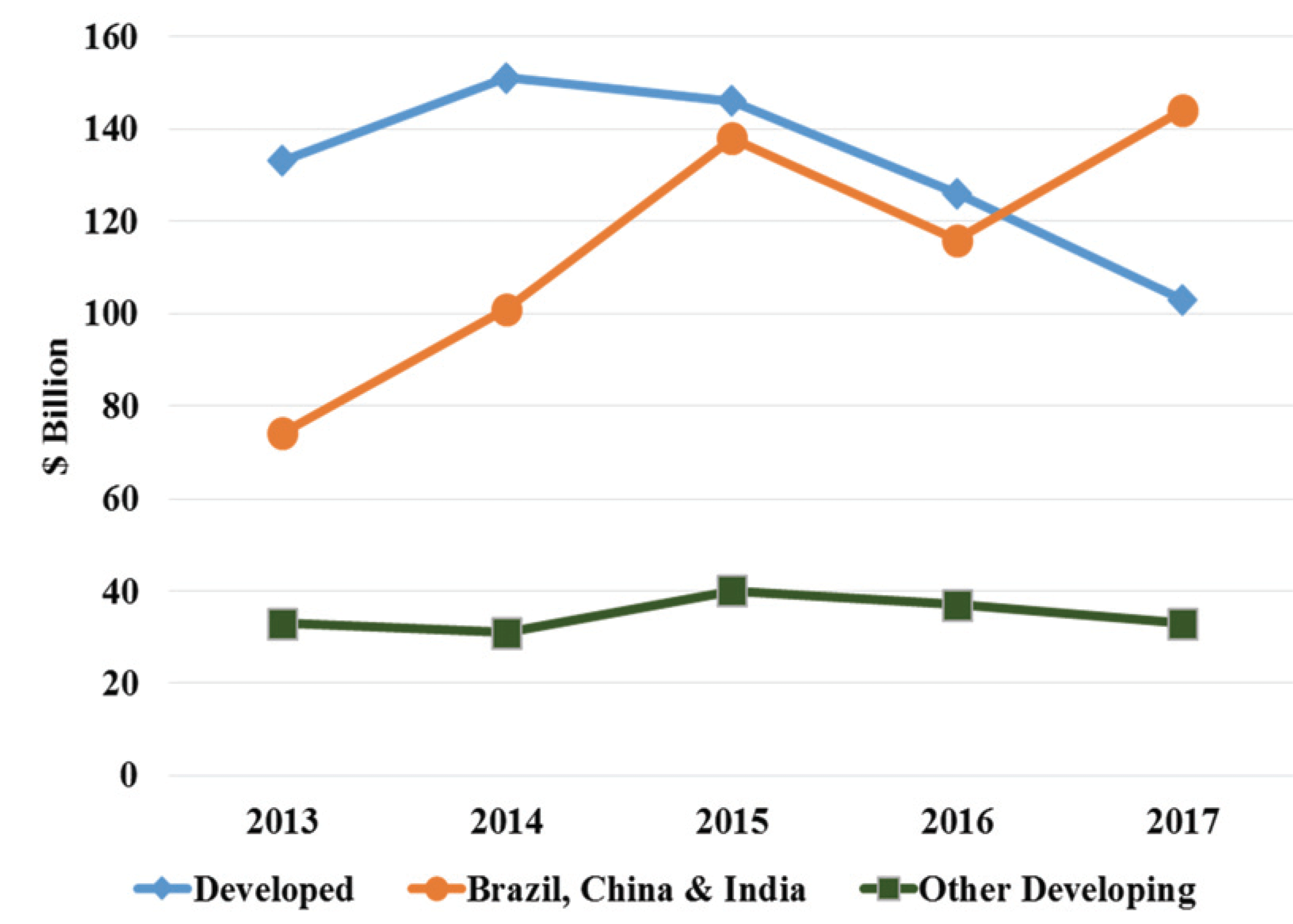
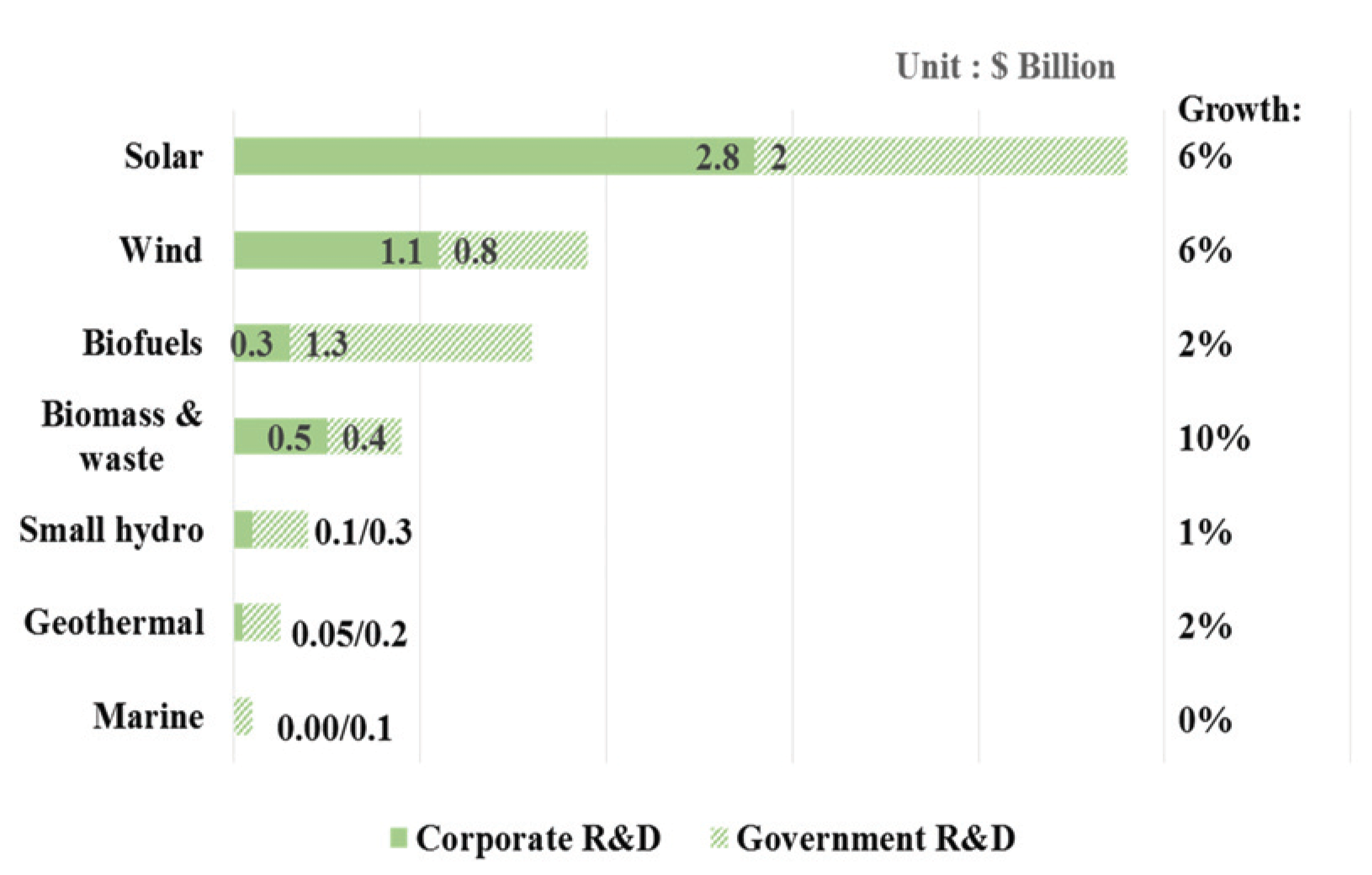
Solar power generation showed a 6% growth from 2016 to 2017, recording 4.7 billion USD. Wind power generation recorded investment of 1.9 billion USD. Investment in the biofuels section was increased by about 2% to 1.7 billion USD35) (BNEF, 2018). According to UNEP, whereas corporate R&D expenses are responsible for about half of solar and wind power generation, government R&D investment takes up about four-fifths of biofuels. Given such a difficult situation, a 2% increase can be interpreted as a positive outcome. Research on renewable energy in developing countries is not as active as developed countries, mostly due to the absence of advanced technologies and the lack of research expenses. Accordingly, the scope of biofuel research can be expanded by resolving these problems.
IRENA36) expects that Indonesia's GDP will increase from 0.3% to 1.3% by 2030 but it is only in the energy field (IRENA, 2017a). Jobs related to renewable energy will research over 1.3 million in 2030 which is considerably higher compared to 101,800 jobs in 2015 (IRENA, 2017a). In addition, it is possible to solve insufficient training on renewable energy by establishing a technical education curriculum through expansion of training in rural areas to create jobs. REmap37) anticipates that energy intensity in ASEAN economy will decrease up by approximately 30% from 2005 to 2025 and this mostly meets the ASEAN's goal to improve energy intensity (IRENA, 2016). Discussions on sustainability of biofuel focus on changes in direct and indirect use of land as well as GHG emission (Frank et al., 2013). Recently, concerns over negative effects of biofuel on biodiversity and loss of habitats were suggested. In conclusion, however, a combination of REDD38) and comprehensive policies such as land use transition are considered to be improving overall effects of policies in terms of preservation of biodiversity (Frank et al., 2013). Each government must strive to improve energy security by reinforcing regional and international energy cooperation, diversifying energy income sources and developing renewable energy. As mentioned in chapter 2 and 3, what needs to be noticed when conducting RFS and REDs is that the Renewable Fuel Standard plans have been adjusted down in some cases. In Fig. 6, there is a difference in the RFS target and the actual consumption of biofuel in Indonesia. It is important to learn that more practical and feasible plan must be set rather than making an impractical plan.
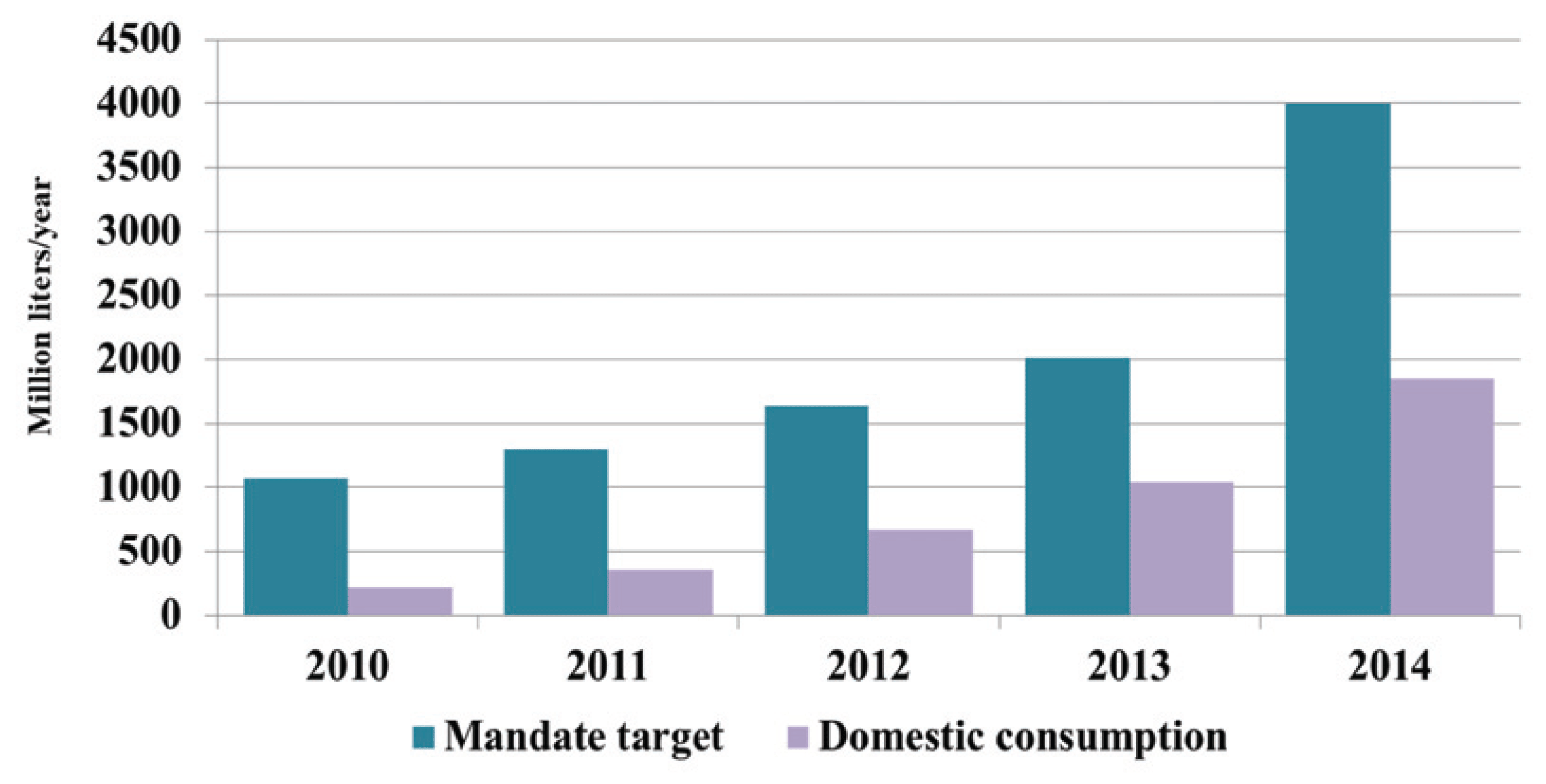
Fig. 7 and 8 show supply potential of biodiesel and bioethanol in the U.S. and South East Asian countries by year and country from 2013 to 2040. Bioethanol demands in South East Asia are steadily increasing in the prospect years because the transportation energy demand is rapidly increasing whilst the potential supply is still low (APEC, 2016). Bioethanol production in South East Asia cannot meet the increasing demand from 2030 to 2040, and consequently, some countries must develop and allocate the sources of advanced bioethanol materials or secure additional supplies from overseas producers (APEC, 2016). It is judged that governmental supports are needed for some countries to strengthen existing measures and set the higher blending target to increase the biofuel demands and use available potential.
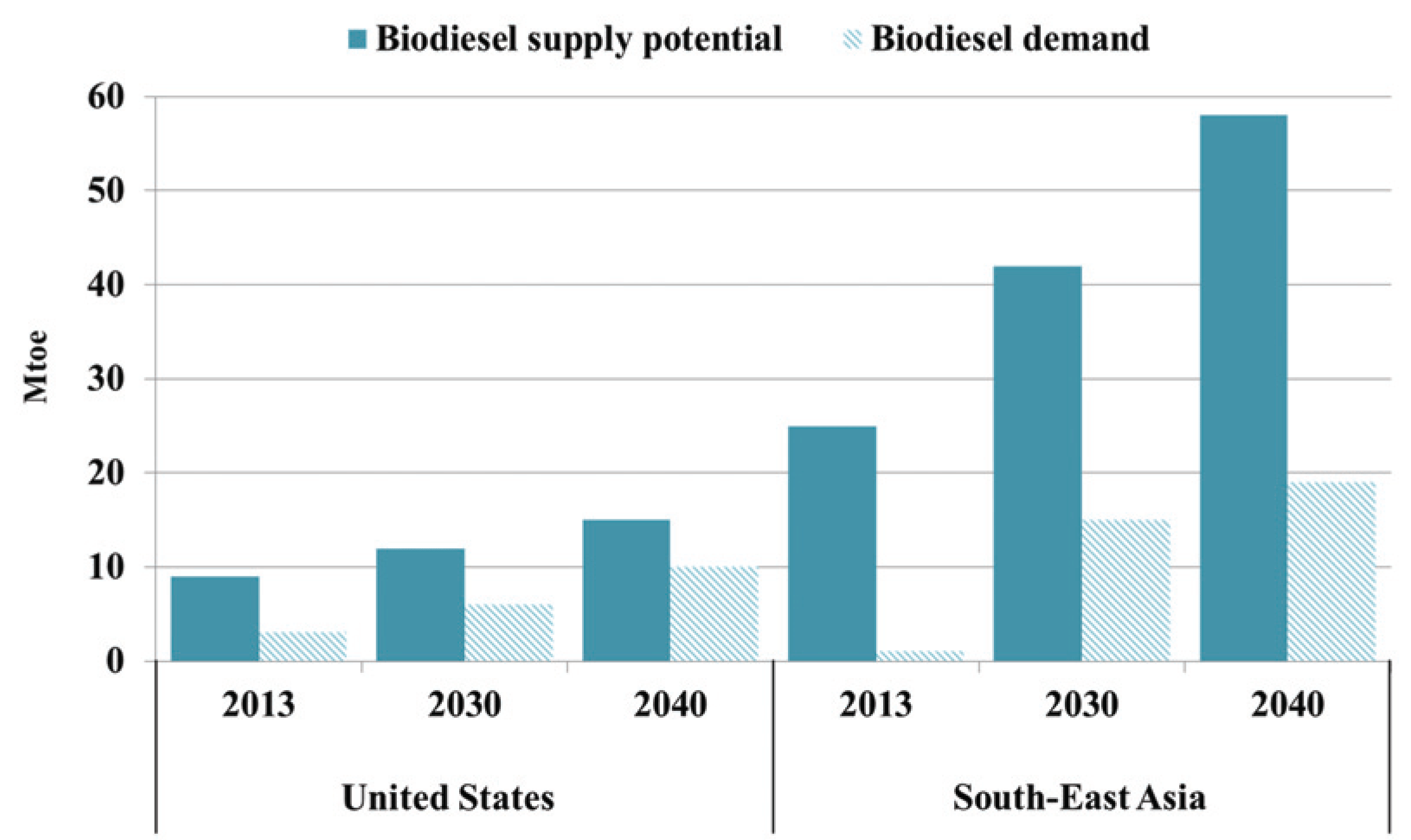
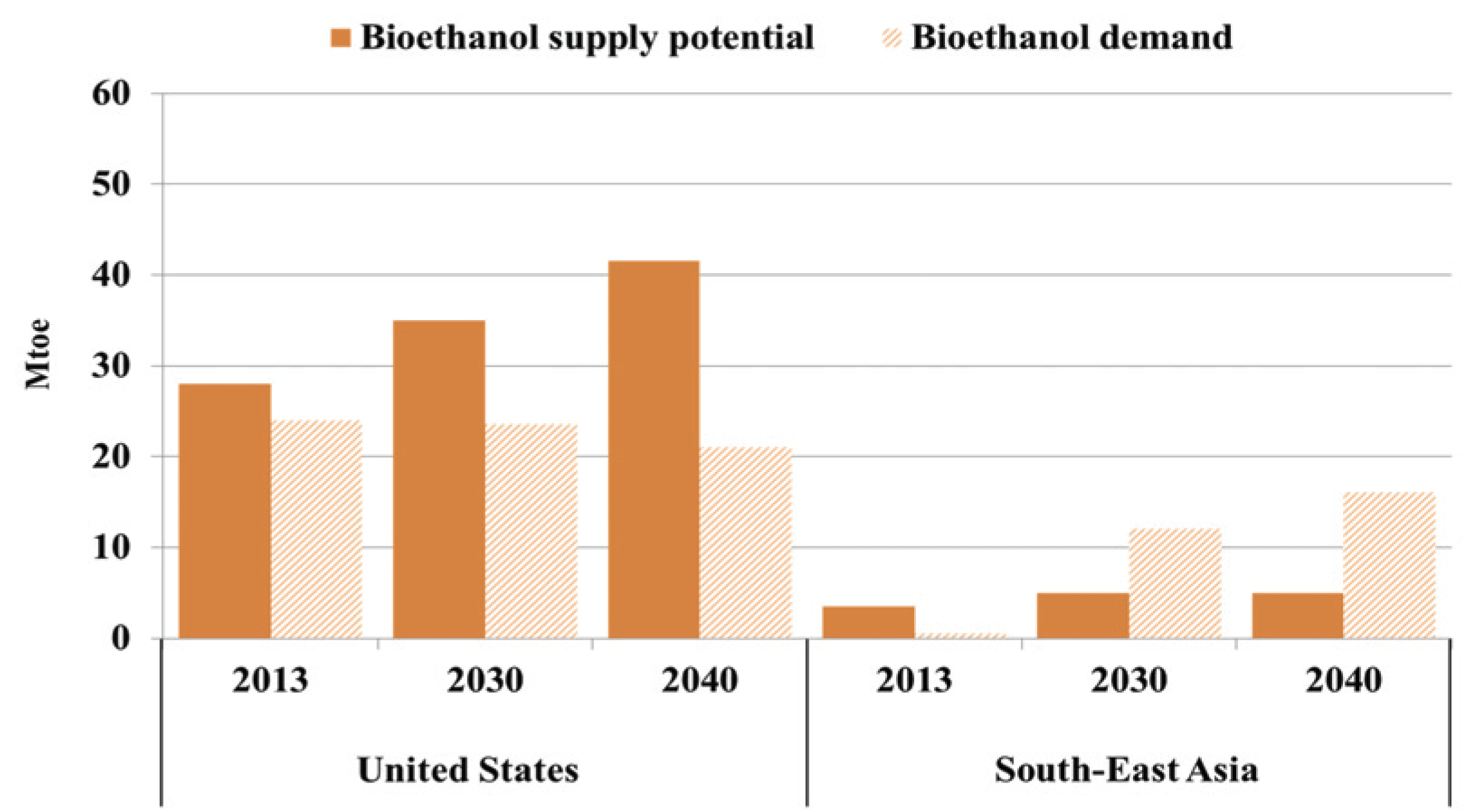
4. CONCLUSION
Biofuels are not something that only exists in laboratories, but they are currently being used as an alternative fuels. Considering that the U.S. and the EU are implementing policies of bioenergy and biofuel at a national level through RFS and RED, it is necessary for ASEAN countries to actively establish policies in this field. Furthermore, in an effort to diversify fuels and cope with climate change, each government can realize sustainable policies by setting a goal to gradually increase Renewable Fuel Standard for biofuels. It is necessary to continue with research on technologies that use cellulosic biomass and microalgae, which can replace the first generation (conventional) biomass considered as a food resource, in future. Subsidy policies, tax benefits and smooth supply of fuels will have a significant effect in the development of biofuel technologies of each country.
As a result of examining the situations of the U.S., Brazil and Europe with high availability of biofuels, it is important to understand the current status of biomass resources in each county for active utilization of biofuels in ASEAN countries. In addition, efficient economic policies of the developed countries such as supply and demand of renewable energy must be reflected to establish necessary laws.

